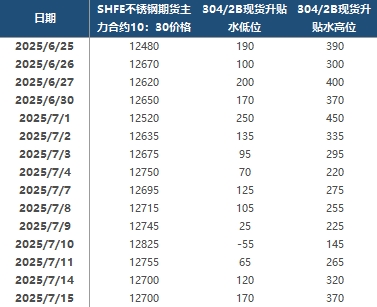






SMM reported on July 16 that the SS futures market initially surged in the morning but then weakened and pulled back, continuing the doldrums from the previous day. In the spot market, influenced by the morning's surge in the futures market, spot prices remained strong, similar to the previous day. However, as the futures market began to weaken and pull back, coupled with the already sluggish high-priced stainless steel transactions, spot prices once again pulled back. At this stage, due to production cuts by stainless steel mills, social inventory did not rise further, and the pressure on stainless steel mills to sell their products also eased. However, downstream demand remained weak, and the spot market fundamentals were in a stalemate, significantly influenced by the futures market. In the short term, the market awaited guidance from macroeconomic policies.
In the futures market, the most-traded contract 2509 was in the doldrums. At 10:30 a.m., SS2509 was quoted at 12,710 yuan/mt, up 10 yuan/mt from the previous trading day. In the Wuxi region, the spot premiums/discounts for 304/2B stainless steel ranged from 110 to 310 yuan/mt. In the spot market, the cold-rolled 201/2B coils in Wuxi and Foshan were both quoted at 7,600 yuan/mt; the cold-rolled untrimmed 304/2B coils had an average price of 12,750 yuan/mt in Wuxi and the same in Foshan; the cold-rolled 316L/2B coils were priced at 23,700 yuan/mt in Wuxi and the same in Foshan; the hot-rolled 316L/NO.1 coils were both quoted at 23,200 yuan/mt in the two regions; and the cold-rolled 430/2B coils were both priced at 7,100 yuan/mt in Wuxi and Foshan.
Despite the SS futures market's rebound and price strengthening, the spot market fundamentals for stainless steel have not yet significantly reversed. The current market is still in the traditional consumption off-season, with summer heat further weakening some downstream demand. Although the previous news of production cuts by steel mills boosted market confidence and improved the sluggish transaction situation, the inventory pressure on stainless steel remains significant. The in-plant inventory, front-end warehouses, and social inventory of stainless steel mills are all at relatively high levels. During the off-season, the inventory destocking speed is slow, delaying the repair process of the supply-demand relationship. Influenced by expectations for production cuts by stainless steel mills, the procurement price of high-grade NPI has further declined, weakening the cost support for stainless steel. In summary, the current stainless steel market is facing multiple pressures from large inventory, weak demand, and weakened cost support, and the repair of the supply-demand relationship still requires time.

For queries, please contact Lemon Zhao at lemonzhao@smm.cn
For more information on how to access our research reports, please email service.en@smm.cn